Mat with an elephant and a horse. The cyclic method "Caucasian captive"
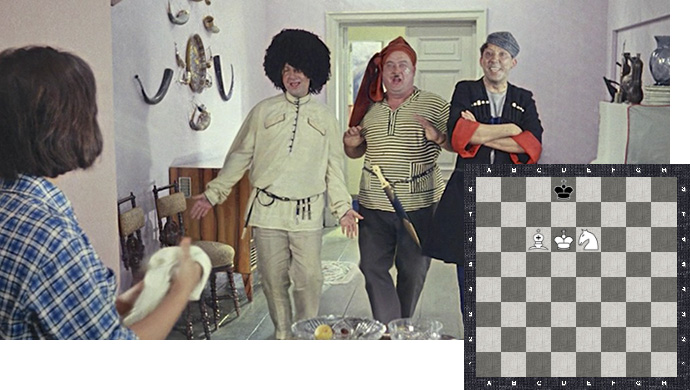
Having disassembled the bones of the two methods of matting with an elephant and a horse ( TWIX and " Deletan" ), it was necessary to shovel a fairly large number of parties where this ending was met. In the vast majority of the lonely king, they are beaten with a “twix”, in other rare cases, something deletan-like is used. Yes, and Wikipedia describes only these two methods, without mentioning whether there are any other systemic methods to mate an elephant and a horse.
It seems like all the dots on e in this topic are dotted, but one party stubbornly haunted me.

Here it is - Gufeld - Palatnik, Tbilisi Open Championship, 1973 . The circumstances in which the match proceeded deliver no less than the game itself (the game was accompanied by scuffle, and after all, there were another 30 years before the official chess boxing matches). Intellectually and physically clashed 23-year-old Simon Palatnik and 37-year-old Eduard Gufeld.
The uniqueness of the party lies in the fact that Palatnik, who could not play this ending, was forced to invent his own matting method right at the board. It should be noted right away that the method is not self-sufficient and is applicable only if the opponent strives at all costs to a safe (i.e., inaccessible to the elephant) angle. In this case, the strongest side is the strictly cyclical moves of the king, elephant and horse that accurately translates the enemy king into a matte corner. If an opponent tries to make a breakthrough and himself rushes towards the dull corner, using this method it becomes impossible to complete the game. However, the figures of the matting side can easily be rearranged into the Deletan triangle and thereby complete the match in their favor in another way.
The “Caucasian Captive” method is not described anywhere in chess theory; the time has come to fill this gap. For simplicity, we will further assume that the strongest side is white, their elephant is white-field. The black king is already in the upper right corner, which is safe for him. White wants to translate the enemy king into the matte upper right corner on the board. At the same time, Black adheres to such a defensive strategy: try at all costs to return to a safe corner. We do not consider the option when Black tries to break through, running away towards the matte corner.
Base position
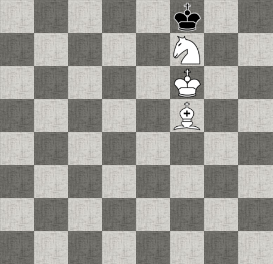
In order to start somewhere, in a safe corner, White needs to build the structure that you see in this diagram. At the same time, White should be in this position. In this case, White can begin to rotate his cyclic combination.
If Black moves in this diagram, then White should start his method prematurely, but first you need to take the right move from Black. Below is an example of a game where, among other things, it is shown how to transfer a move in a given situation.
Horse stabilization
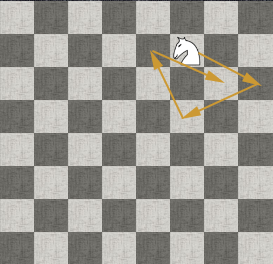
Then White needs to make the initial stabilization of the knight, i.e. transfer him to that position, from which he will be able to repeat simple movements.
The transfer of the horse to a neighboring cell is combined so as not to let the enemy king go to the very corner. Therefore, the diagram shows the correct 4-step trajectory for the horse, although the transfer between these two cells could be carried out in 2 turns.
In the following step-by-step example, this stabilization will also be shown.
After the knight has been moved to the desired position from the base position - in fact, then the whites move exclusively in a periodic style.
T cycle
White pieces dance in front of the black king, taking away the fields from him and thereby forcing them to drift a little towards the dull corner. The entire creative team repeats the letter T on the board.
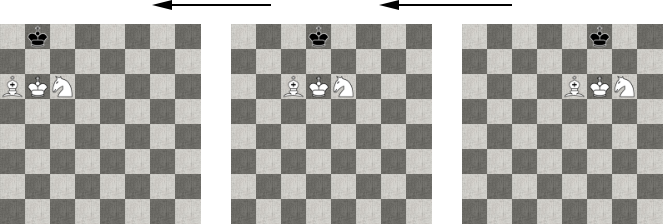
In this dance, each member of the white ensemble individually writes rather unpretentious steps, although this simplicity is deceiving.
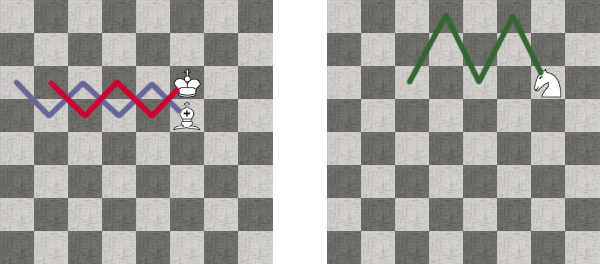
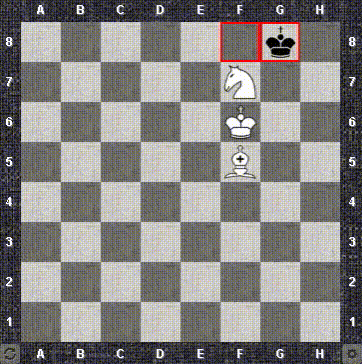
These movements should be made in the right order. In this case, the white trinity acts as a coordinated mechanism, moving themselves they force the opponent to move in the right direction.
An example of a T-cycle in the method "Caucasian captive"
In this example, Black’s strategy is to strive at a safe angle h8 at all costs. White pedantically takes away the black squares, forcing the enemy king to move towards the opaque corner a8 .
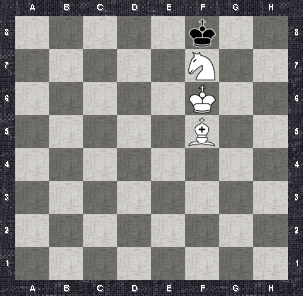 | Let's start from the base position in which Black moves. If White had a move now, then they would begin to implement their method. But since it is Black’s move now, White needs to come to this position again, but with his own move. |
| 1. ... Kf8-g8
2. CF5-G6 Kpg8-F8 3. Cg6-h7! ... | |
|---|---|
 | We do not allow the black king to return to the vicinity of a safe corner, where he was so comfortable. Before us is the letter T from the TWIX method, which, in principle, can now be applied. But this time we will go the other way. |
| 3. ... Kf8-e8
4. Ch7-f5! Kpe8-f8 | |
 | The transfer of the move took place. Before us is again the basic position, but now White’s move. White begins to stabilize the knight. |
| 5. Kf7-h6 Kf8-e8 | |
 | Black would be glad to go to g8 (closer to the safe corner), but the knight controls this field. |
| 6. Cf5-e6 Kpe8-f8 | |
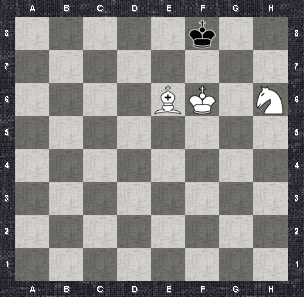 | Blacks do not make a breakthrough in the direction of the “matte” corner, since in this case White immediately changes into the external Deletan triangle:
6. ... Cre8-d8 7. Be6-f7 and 8. Kh6-f5 |
| 7. Kh6-f5 Kpf8-e8
8. Kf5-e7 Kpe8-f8 9. Ke7-g6 + ... | |
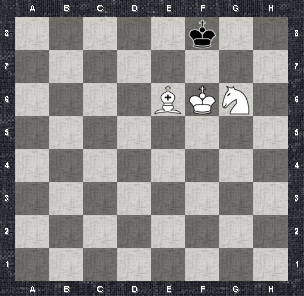 | The horse is stable. And the letter T , similar to that which is now on the diagram, we will see more than once. |
| 9. ... Kpf8-e8
10. Kpf6-e5 Kpe8-d8 11. Kpe5-d6 Kpd8-e8 | |
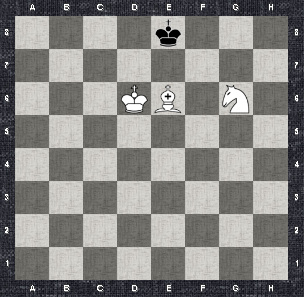 | The horse does not allow to break through the black fields, and the elephant through the white. The white king quietly moved to the left. |
| 12. Ce6-d5 Kpe8-d8
13. Cd5-c6 ... | |
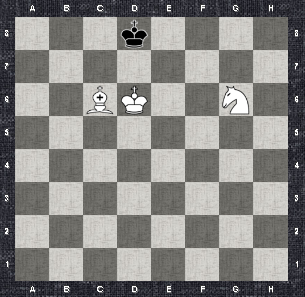 | After we moved the white king closer to the left edge, we transfer the elephant in small steps. In no moment does the black king have the opportunity to slip back into a safe corner.
It remains now to move the horse. |
| 13. ... Kd8-c8
14. Kg6-f8 Kpc8-d8 15. Kf8-e6 + ... | |
 | The T- cycle wheel made a complete revolution. We got the same position as on the 9th move, just with the displacement of all the actors to the left.
The next 7 moves are absolutely similar to moves 9 through 15, only with a shift of 2 verticals to the side. |
| 15. ... Kd8-s8
16. Kpd6-c5 Kpc8-b8 17. Kpc5-b6 Kpb8-c8 18. Cc6-b5 Kpc8-b8 19. Cb5-a6 Kpb8-c8 20. Ke6-d8 Kpc8-b8 21. Kd8-c6 + ... | |
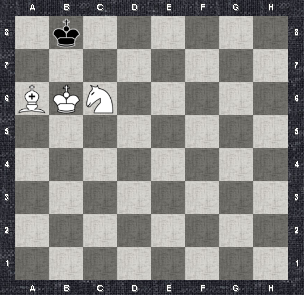 | Another revolution and before us again the letter T. Hello, matte corner. |
| 21. ... Kpb8-a8
22. Ca6-b7 × | |
 | Everything. |
I-cycle
In another variation, in addition to T , the structure in the form of a capital vowel I is repeated.

The king and the elephant move along exactly the same sinusoids as in the T- cycle. But the horse makes trickier twists, stitching such knots on the board. It turns out so cyclically so cyclically!

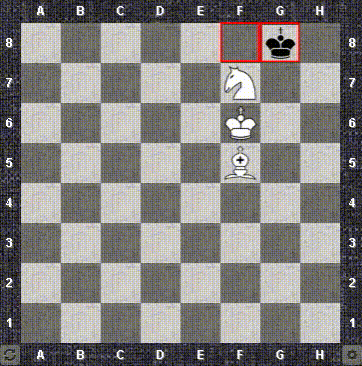
If you show all the cells that the horse visited (and he visits each field no more than once), then they will make up almost a third of the chessboard.
This option is noticeably longer than the previous one, but IMHO, more spectacular.
An example of the I-cycle in the method "Caucasian captive"
 | Let's start from the base position, in which Black moves again. We show the progress transmission without comment, since everything is explained in a step-by-step analysis for the T- cycle. |
| 1. ... Kf8-g8
2. CF5-G6 Kpg8-F8 3. Cg6-h7! Kf8-e8 4. Ch7-f5! Kpe8-f8 | |
|---|---|
 | After the transmission of the course, we stabilize the horse. So far, everything is the same as in the case of the T- cycle. |
| 5. Kf7-h6 Kf8-e8
6. Cf5-e6 Kpe8-f8 7. Kh6-f5 Kpf8-e8 8. Kf5-e7 Kpe8-f8 9. Ke7-g6 + ... | |
 | The horse is stable. White gradually moves his pieces to the left, simultaneously taking away from the black king the fields on the right flank. |
| 9. ... Kpf8-e8
10. Kpf6-e5 Kpe8-d8 11. Kpe5-d6 Kpd8-e8 12. Ce6-d5 Kpe8-d8 | |
 | Prior to this move - a complete repetition with a T- cycle, in which 13. CD5-c6 subsequently followed. |
| 13. Kg6-e5 ... | |
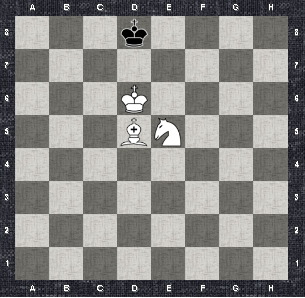 | The last time in this position we put up a barrier with the help of only the elephant and the king, this time we will also use the horse! |
| 13. ... Kd8-e8
14. Ke5-d7 Kpe8-d8 | |
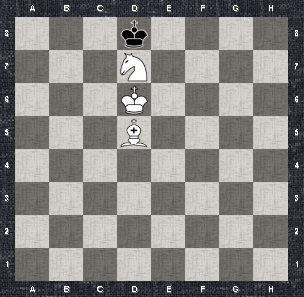 | Yes, this is the basic position (with White's move), only shifted two verticals to the left! I- cycle made the first full revolution.
Once again we got the basic position in the course of White, then again we need to stabilize the knight. Repeating the explanation of the next 10 moves makes no sense - these are the same moves from the 5th to the 14th, only everything is shifted to the left by 2 cells. |
| 15. Kd7-f6 Kpd8-c8
16. Cd5-c6 Kpc8-d8 17. Kf6-d5 Kpd8-c8 18. Kd5-c7 Kpc8-d8 19. Kc7-e6 + Kpd8-c8 20. Kpd6-c5 Kpc8-b8 21. Kpc5-b6 Kpb8-c8 22. Cc6-b5 Kpc8-b8 23. Ke6-c5 Kpb8-c8 24. Kc5-b7 Kpc8-b8 | |
 | The familiar sausage rolled to the left.
I- cycle made the last turn. This is again the basic position after which again (for the last time) we stabilize the horse. |
| 25. Kb7-d6 Kpb8-a8
26. Cb5-a6 Kpa8-b8 27. Kd6-b5 Kpb8-a8 28. Kb5-a7 Kpa8-b8 29. Ka7-c6 + Kpb8-a8 30. Ca6-b7 × | |
 | Mat. |
Practical use
Although this method was found in a tournament game, the chances of using it in practice are low. The naked king easily destroys the cycle of enemy figures if he simply stops trying to return to a safe corner. In this case, I repeat, the strongest side is to rebuild the figures in the Deletan triangle and drive them into the matte corner in a different way.
It is worth remembering that the cyclic method is noticeably longer than the TWIX method. In our illustrative examples with the transfer of the move and the primary stabilization of the knight, the T- cycle lasted 22 moves, and the I- cycle is all 30 in general. While the “Twix” from the same initial position in the correct execution does not even reach 20 moves . If the naked king makes an attempt to escape through the dull corner, then you have to mate with the Deletan method - and this, too, can stretch for even more moves. Therefore, if we apply the cyclic method in the name of art, then with an eye to the rule of 50 moves.
Rather, this method is interesting as a kind of mathematical curiosity on a chessboard, when three completely different pieces act as an original pendulum mechanism.
other methods
Click on the animation to go to the corresponding article.
 | 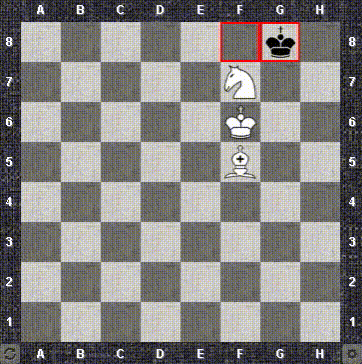 |
|---|---|
| If the opponent tries to break out in the opposite direction from the safe corner, the strongest side easily builds Deletan triangles . | If you just need to checkmate without bothering with exotic methods, then it is easier and faster to use the TWIX method . |
Training
Not every chess bot will be able to practice this method. On lichess.org or chess.com, Stockfish engines, if you set a sufficiently high level of complexity, do not at all try to return to a safe corner at all costs, but instead go on a breakthrough, abruptly running away towards the matte corner. There you have to mate with the good old Deletanov method.
In the simulator, kindly provided by GlukKazan , the bot pulls into a safe corner with a powerful magnet. Here you can try even a T- short, at least I- long cycle. Click on any of the charts.
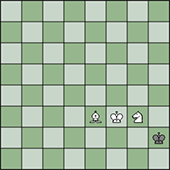
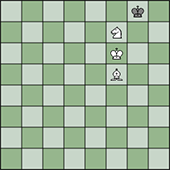
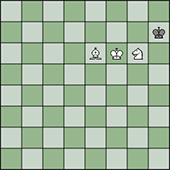
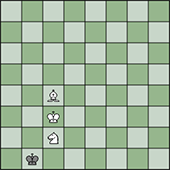

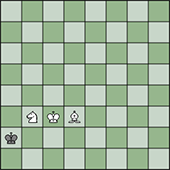
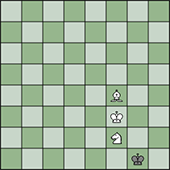

All Articles